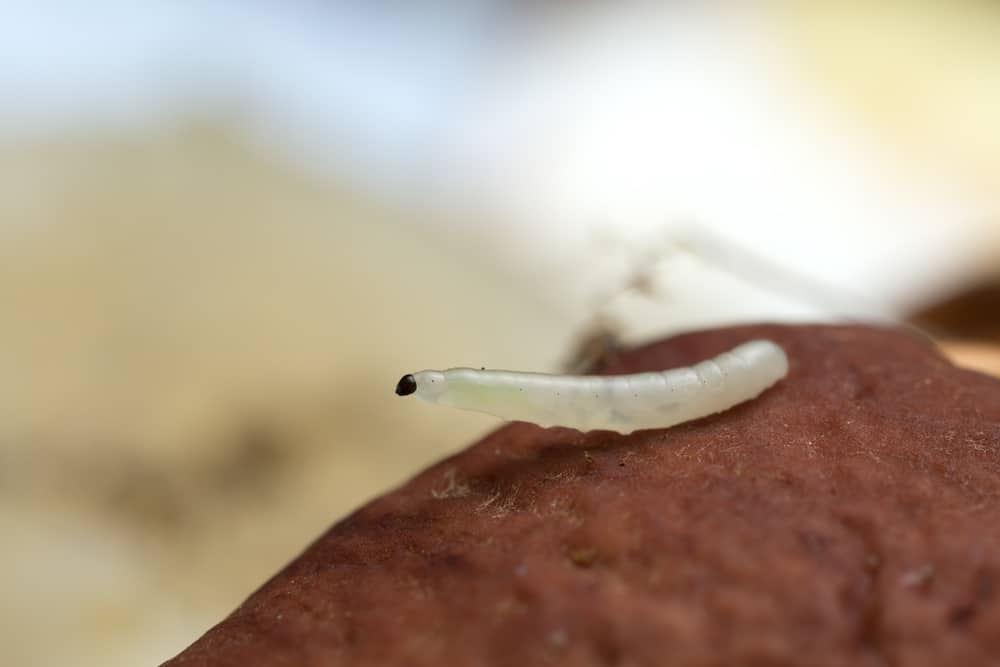Summary
Fungus gnat larvae are more likely to live in damp or moist, and especially overwatered, soil.
Look for white-to-cream wormlike organisms with dark heads that wriggle to move and are no more than ¼ of an inch in length. You may struggle to find them, though, as they live near roots.
While fungus gnat larvae do feed on dead organic matter, they can also feed on roots. This can be especially damaging for seedlings.
Sprinkle cinnamon on your soil and address any overwatering issues to help reduce their population. Consult with a professional if needed.
Identifying
Look for the following factors to identify fungus gnat larvae:
- No more than ¼ of an inch in length
- Translucent
- They resemble worms
- White to cream in color
- Dark heads
- They wriggle to move
- Decaying organic matter (more on that below)
- Overly moist or overwatered soil (more on that below)
This list will help you identify if you’re dealing with fungus gnat larvae. However, it’s still possible to confuse one organism with another.
Whether you think you’re dealing with a fungus gnat larvae or another kind of infestation, remember to consult with a local professional. Tell them what you already know and work with them to develop an understanding of what’s in your soil as well as what to do about it. Stress that you’re looking for organic solutions.
Causes (Why They’re There)
Like pot worms, fungus gnat larvae (and fungus gnats) are likely already in your soil.
You’re more likely to find them in moist or overwatered soil. They prefer this kind of environment, which also creates more decaying organic matter. This, in turn, gives them more food to eat and break down.
As you can probably guess, with a cycle like that, you’re going to end up with more of them sooner than later.
Benefits
Fungus gnat larvae provide a variety of benefits for your garden, lawn, and the plants within them. In short, among others, they’re detritivores, they provide nutrients to your plants, and they improve the soil structure.
Let’s start with them being detritivores.
They’re Detritivores
Detritivores are any organism that eats dead organic matter.
Detritivores are a very necessary part of nature. Because they eat dead organic matter, they effectively clean up environments. In other words, if detritivores didn’t exist, there’d be a whole lot more dead plants and animals lying around.
Thankfully, though, they do.
Because they eat dead organic matter, they also provide another benefit, one specific to your plants.
They Provide Nutrients To Your Plants
Detritivores like fungus gnat larvae accomplish what fertilizers do: providing nutrients to the soil. This, in turn, allows your plants an opportunity to absorb those nutrients through their roots. Some plants or parts of plants die, giving detritivores more food to eat, which they turn into more nutrients.
This is the nutrient cycle, and the larvae have their part to play in it.
Soil Structure Improvement
Another benefit (but certainly not the last) that fungus gnat larvae provide is improving soil structure. This comes about as a natural consequence of them moving through said soil. As they move, they create tunnels that improve air and water flow and help prevent soil compaction.
In case you don’t know, soil compaction refers to soil that gets packed down due to foot traffic or other issues. Not only does soil compaction affect water and air flow (which affects plant growth), but it also affects how well plants’ roots grow through said soil.
Problems
Fungus gnat larvae can cause several problems for you and your plants. In short, they feed on plant roots, can be a sign of overwatering, and can affect seedling growth.
Let’s start with them feeding on plant roots.
They Feed On Plant Roots
Unfortunately, fungus gnat larvae can feed on your plants’ roots. It would be great if they only fed on dead organic matter, but they don’t.
If this goes on for long enough, or if there’s enough of them in your soil, your plants’ roots can suffer serious damage. Since your plants receive their food and water from the soil through their roots, this threatens their ability to be healthy.
Fungus Gnat Larvae Can Be A Sign Of Overwatered Soil
Fungus gnat adults and fungus gnat larvae prefer moist soil. Obviously, soil will be moist at least some of the time due to natural or human watering.
However, their presence can indicate an issue with overwatering. This can occur due to heavy and prolonged rainfall, human error, or poor drainage.
While fungus gnats and their larvae can be a problem on their own, it’s also essential to look for and treat these issues that can cause them.
They Affect The Growth Of Seedlings
Fungus gnat larvae don’t care if the plant roots they feed on come from a mature plant or a seedling.
The difference is mature plants are established. They have more roots and can survive damage to those roots.
Seedlings cannot, so the larvae can be especially problematic for them.
Is It Good For Your Lawn And Garden?

Fungus gnat larvae are not the worst pest you can be dealing with. Reasons exist for you to have them, and reasons exist for you to not have them, as shown above.
Ultimately, fungus gnat larvae provide many necessary benefits to your plants and the Earth. But if you notice too many or they’re affecting your plants adversely, then it’s time to look into how to remove and prevent them.
Attracting
You don’t have to do anything to attract fungus gnat larvae. They’ll show up on their own if you provide them with the right conditions (too much moisture in the soil).
Support And Care
Fungus gnats and fungus gnat larvae will take care of themselves.
Additionally, it’ll be hard to do much for the larvae since they live near plant roots. You likely won’t even notice them until they become adults.
Treating
You’ve got a few options for treating fungus gnat larvae (and fungus gnats).
Option one is to let your soil dry out. Since they like moist or damp soil, this will help reduce their numbers.
Option two is to sprinkle some cinnamon into your soil. Cinnamon helps treat fungus and also fungus gnats and their larvae.
Option three is hanging yellow sticky traps near affected plants, which can help reduce their populations.
Preventing
The best thing you can do to prevent fungus gnat larvae (and fungus gnats) is to make sure your soil isn’t overwatered.
You have a few ways to do so, too. These include improving drainage by ensuring your soil isn’t compacted or building structures or slopes to help divert some water away from that area.
Additionally, you can adjust how you water your garden and plants. We recommend doing this carefully, though. While overwatering is definitely an issue you want to avoid, underwatering is another one.
So, as you adjust how much and how often you water, monitor your plants for any negative effects.
